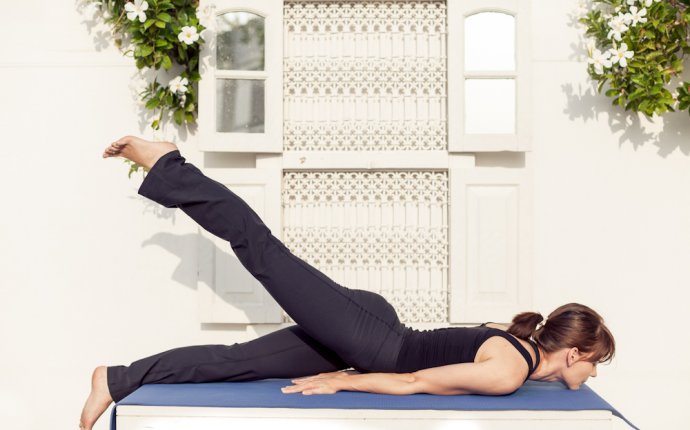
Lower back Stretching Exercises
Recovering from Lower Back Injuries & Workouts to Prevent Injury
We all are susceptible to lower back injuries - military, law enforcement, advanced athlete, beginning exerciser, or sedentary person - we all get back injuries of some sort. The back injuries seen most in doctor's offices and chiropractic clinics worldwide involve the lower back/hip region and can occur from a variety of different causes. According to Dr. Steve Erle D.C. and physical therapist of the Maryland Disc Institute, most of the injuries in the region are lower back muscle pulls or tears, disc inflammation, or the spine itself. These three types of lower back injuries can occur from falling, stretching, lifting, sleeping in an awkward position, or in some cases, no noticeable reason at all. Usually, all occur due to lack in flexibility and balance of hip, abdominal, and lower back muscle strength.
Each of these injuries seems to manifest themselves in the form of the back spasm, which is the body's way of immobilizing the injury to prevent further injury. Many forms of treatment can be given to these injuries, from heat, ice, anti-inflammatory, electrical stimulation, ultra-sound, pain killers, and muscle-relaxers. Some studies have experimented with Botox to relax the spasm so the patient can function better and will less pain.
One of the most interesting studies I have heard related to the effectiveness of the following three treatments:
1) Electrical Stimulation and Massage
2) Bed Rest and Pain Killers
3) Nothing but Stretching
Strangely, all had about the same full recovery period. The "Lower Back Plan" (PDF) discusses and illustrates preventative exercises and stretches to strengthen the torso and create balance between the hips, abdominals and lower back. These three muscles groups often oppose each other and must be equally flexible and strong in order to prevent injury in one or the other. Many advanced athletes may have super abdominals, but have neglected to exercise the lower back. This can cause the lower back stress since abdominals will flex while the lower back stretches. If the lower back, legs, and hips are not flexible or strong, the lower back will pull involuntarily, usually causing spasms.
The following stretches will help create flexibility. There are more exercises and workouts you can follow from any of the eBooks in the Military.com Fitness eBook store or you can surf the internet and go to a favorite site of mine for sport injuries titled - There you can learn about almost any injury and get free tips to prevent them.
Knees to Chest
Bring your knees to your chest as shown. You have the option of pulling your knees closer to your chest with your arms and relaxing your upper back and next by laying your head on the floor as well.
Hamstring Stretch #1
From the standing or sitting position, bend forward at the waist and touch your toes. Keep your back straight and slightly bend your knees. You should feel this stretching the back of your thighs. The lower back is directly affected by the hamstrings. Usually if your hamstrings are too tight and you cannot bend over to touch your toes, your lower back is also inflexible and weak and waiting to be injured.
Lower Back Hamstring Stretch #2
Spread your legs while standing.. Drop your chest down to your knees and place your hands on the floor. Hold for 10 seconds, then try to slowly straighten the legs.
Hurdler Stretch
Sit on the floor with your legs straight in front of you. Bend your right knee and place the bottom of your foot on the inside of your opposite thigh. With your back straight, lean forward in order to stretch the back of your legs and your lower back. Hold the stretch for 15 seconds, switch legs, and repeat.
Lower Back Twists
Lay on your right side with knees bent as shown, and slowly twist your torso so your shoulders are flat on the floor. Try to keep your knees stationary.
The following exercises are the ideal non-weighted ways to strengthen the lower back. In fact, if you have ever injured your lower back, you probably did these exercises in rehab after the surgery or injury. Doing any physical therapy exercise as part of your daily lower back routine is ALWAYS smart and safe.
Lower Back Exercise
Lie on your stomach with your arms extended over your head. Lift your right arm and your left leg off the ground at the same time and repeat for 20-30 repetitions. Switch arms/legs and repeat.
Lower Back Exercise - Swimmers
Lie on your stomach and lift your feet, knees, and lower thighs off the floor by flutter kicking repeatedly as if you were swimming freestyle.
Upper Back Exercise #1 (Arm Haulers)
Lie on your belly with your feet on the floor. Lift your chest slightly off the floor and wave your arms from your sides to over your head for 30 seconds. Lift your feet and knees off the floor and your lower back, hamstrings, and read end will flex and strengthen.
Upper Back Exercise #2 (Reverse Pushups)
Lie on your stomach in the down pushup position. Lift your hands off the floor instead of pushing the floor. This will strengthen your upper back muscles that oppose the chest muscles. Rear deltoids and rhomboids are the muscles used. Lift your feet and knees off the floor and your lower back, hamstrings, and read end will flex and strengthen.









